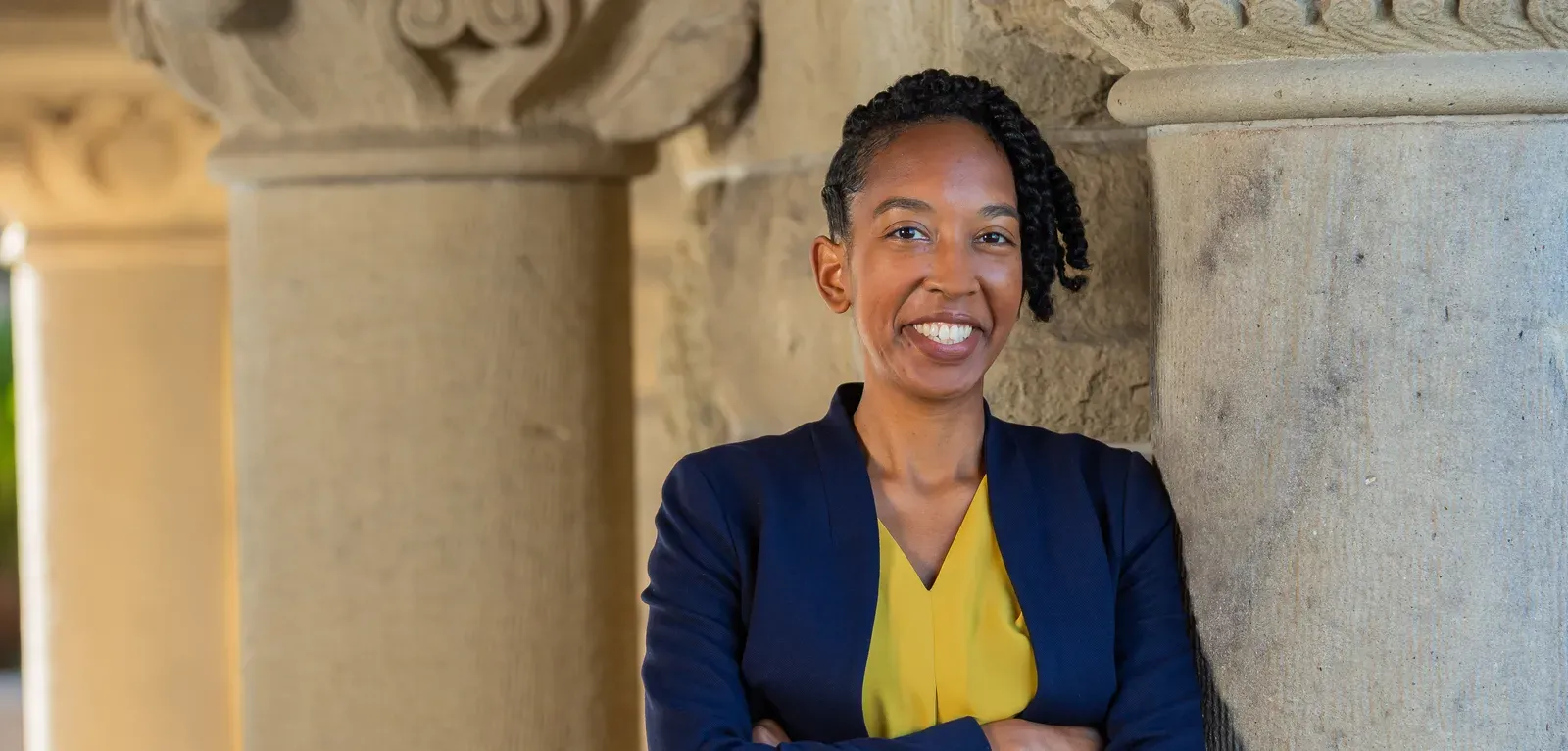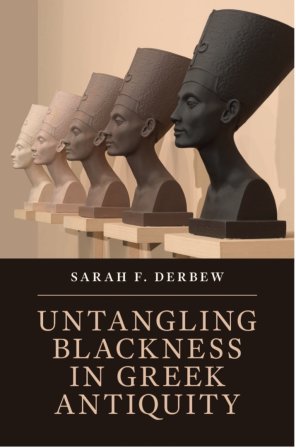
Q&A: New book probes blackness in ancient Greek literature and art
Stanford’s Sarah F. Derbew challenges the notion that modern understandings of race can simply be applied to classical depictions.
Sarah F. Derbew believes you cannot analyze ancient writings and performances solely through the modern lens of race, even though many scholars do.
In her first book, Derbew, an assistant professor of classics who is affiliated with the Center for Comparative Studies in Race and Ethnicity and the Center for African Studies in Stanford’s School of Humanities and Sciences, looks at blackness in Greek writing and performances without conflating modern understandings of skin color with earlier representations. Derbew’s book, Untangling Blackness in Greek Antiquity (Cambridge University Press, 2022), brings together the writer, performer, and audience to question how blackness should be read and interpreted in four texts and visual materials from the fifth century B.C. to the fourth century C.E. in ancient Greece.
For example, in her book Derbew discusses an ancient Greek two-handled drinking cup that has one human head on either side. “Presumptions about skin color have bled into scholarly commentary about the janiform [or ‘two-faced’] cup,” Derbew writes, explaining that analyses of the cup often say one face is Black and the other is white. Furthermore, Derbew pushes back against the unsubstantiated claims that render one side of the cup a caricature of beauty and the other side a paragon of beauty. Derbew says that since the relatively modern Black-white racial binary didn’t exist then, both labels can be misleading. She instead carefully analyzes the physical attributes of the cup in the context of its time and labels the heads “black face” and “brown face” without implying different beauty standards for each color.
Derbew’s research focuses on representations of Black people in literature and artistic renderings from Greek antiquity. She also teaches courses that focus on African cultural heritage as well as classics in the literature and arts of Africa and the Black diaspora.
Here, Derbew discusses her new book, the motivation behind it, and what it means for classical studies, which are focused on the ancient histories of the Greek and Roman empires.
This Q&A has been edited for clarity and length.
Question: What prompted you to write your new book, Untangling Blackness in Greek Antiquity?
Answer: I wrote the book that I would have wanted to read as a student. When I first encountered Aithiopians, people whose name implied skin color (aithō: “I blaze”; ops: “face”), in a Greek text from 2,500 years ago (Herodotus’ Histories), I was floored. I immediately wanted to know more about this group of people who were described as incredibly tall, beautiful, and semidivine. Although others had done pioneering work on this topic (such as African American scholar Frank Snowden Jr. and Caribbean scholar Lloyd Thompson), I recognized that there can be blind spots when you are the “first” to work on a topic—even if your skin color overlaps with the subjects of your research. So I used my predecessors’ work as a foundation from which to create a project that benefits from insights in ancient Greek literature, modern critical race theory, and African studies.
Question: Your book is a rigorous anti-racist study—in what way and how do you define “anti-racist”?
Answer: I define an “anti-racist” study as a work that celebrates the diversity of blackness as it appears in any form or time period and a work that openly critiques one-sided arguments designed to subjugate blackness in any form or time period. To this end, I begin my book by listing my definitions of keywords to ensure that my readers know exactly what I mean when I use words such as “black” (lowercase), “Black” (uppercase), and “race.” I want to explicitly let my readers know that I have thought deeply about my terminology and want to avoid slapping modern terms onto the past without any thought. I also aim to reject static conflations of “race” by inviting future readers to build on, expand, and challenge my arguments in my first chapter. While I am not inviting future readers to attack my personhood, they are welcome to grapple with and revise my concepts; society will always have a need for fresh ideas. In other words, material that is exciting and thought-provoking in 2022 may not remain that way in 2032 or beyond. So I offer this invitation as a way to ensure that we continue to think through and adapt our orthography of blackness in the future.
Question: What are some of the silences, suppressions, and misappropriations of blackness within modern studies of Greek antiquity that your book covers?
Answer: Modernity’s mishandling of representations of black people of Greek antiquity occurs in small and large ways—both do a disservice to curious, open-minded readers. This includes reducing over 100 mentions of Aithiopians (“sun-kissed” people who lived in what is now southern Egypt and northern Sudan) in the ancient Greek corpus to trivial references. Further misappropriations occur when people place great importance on references to enslaved Aithiopians, which undoubtedly appear in ancient Greek sources, and pay little attention to references to Aithiopians as semidivine warriors, which also appear in ancient Greek sources.
Question: How does your analysis and discussion in this book compare to other examinations and studies of race in Greek antiquity?
Answer: While I am in debt to Snowden Jr. and Thompson, two Black classicists who pioneered the study of blackness in ancient Greek literature, I resist their conflation of modern and ancient categories of race without interrogation. I prefer instead to opt for radical hesitation, and I scrutinize my own historical position in my work.
My approach to my source material is composite, in that I draw inspiration from those in my own discipline of classics, such as Rebecca Futo Kenney and Denise McCoskey, who write about race in Greco-Roman antiquity, and I derive my methodology from critical race theorists, such as Saidiya Hartman and Daphne Brooks. Hartman’s and Brooks’ work also gives me intellectual courage to put past and present contexts into conversation in ways that recognize context without reproducing hierarchies or oversimplifying source material.
Question: How does this work connect with contemporary debates about race, identity, and politics?
Answer: My book builds on the groundbreaking work done by critical race theorists such as Hartman, who wrote Scenes of Subjection: Terror, Slavery, and Self-Making in Nineteenth-Century America (Oxford University Press, 1997) and Brooks, who wrote Bodies in Dissent: Spectacular Performances of Race and Freedom, 1850-1910 (Duke University Press, 2006). Their work gave me the intellectual courage to explore earlier permutations of race and skin color. I have tried to model my methodology after these scholars by applying rigor and respect to the subjects of my investigation.
Question: How does this book dovetail to your future work?
Answer: In future projects, I aim to pull African studies and classics closer together. To this end, I am finishing up an essay in which I deem the 14th-century Ethiopian epic Kebra Nagast to be part of a classical canon. This will be part of a volume I am coediting with Dan Orrells and Phiroze Vasunia, Classics and Race: A Historical Reader (forthcoming). As another way to push this needle forward, I’m working on a piece that examines the sophisticated wordplay in two satires—that of Hama Tuma from modern-day Ethiopia and that of Lucian from ancient Syria.





